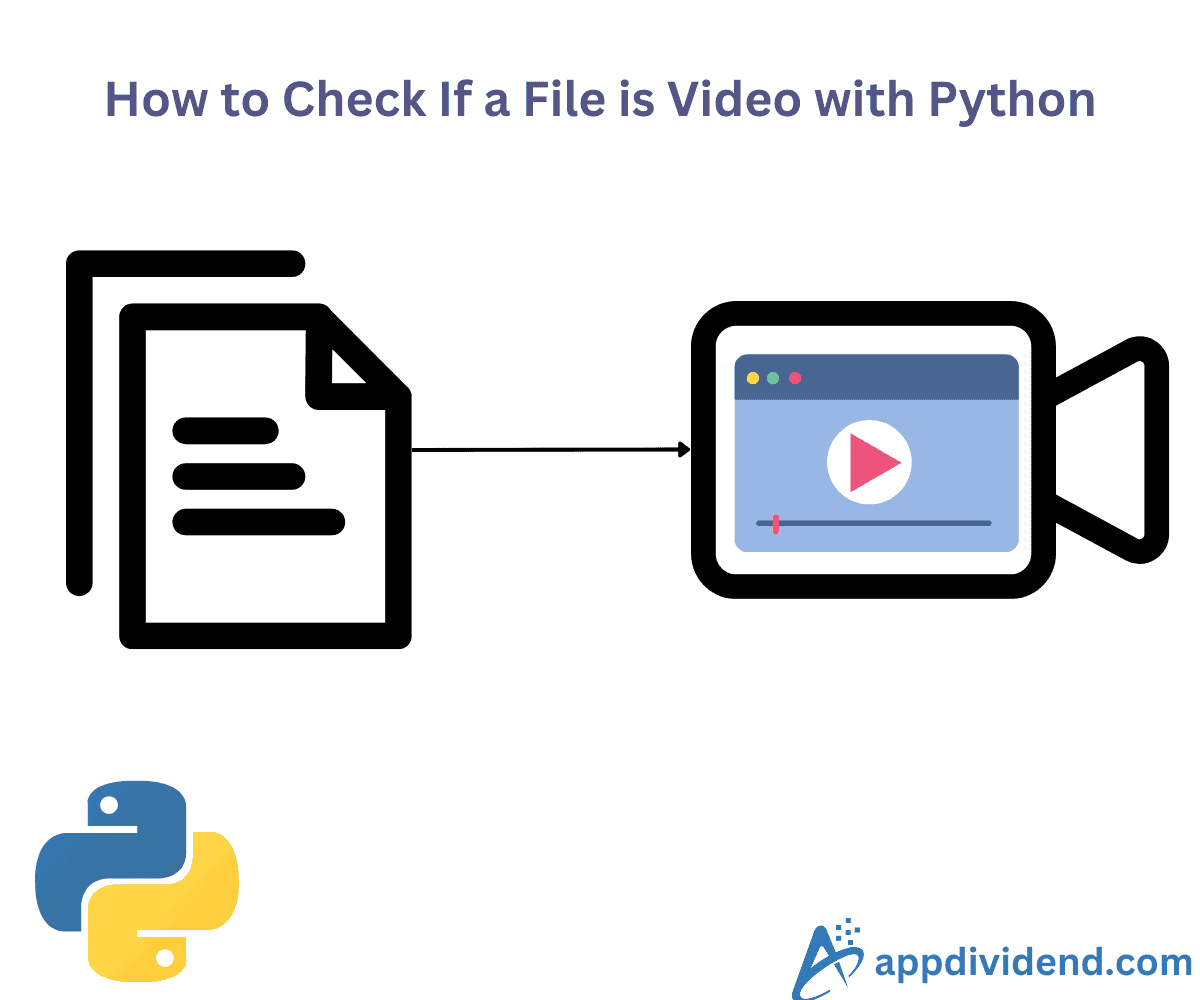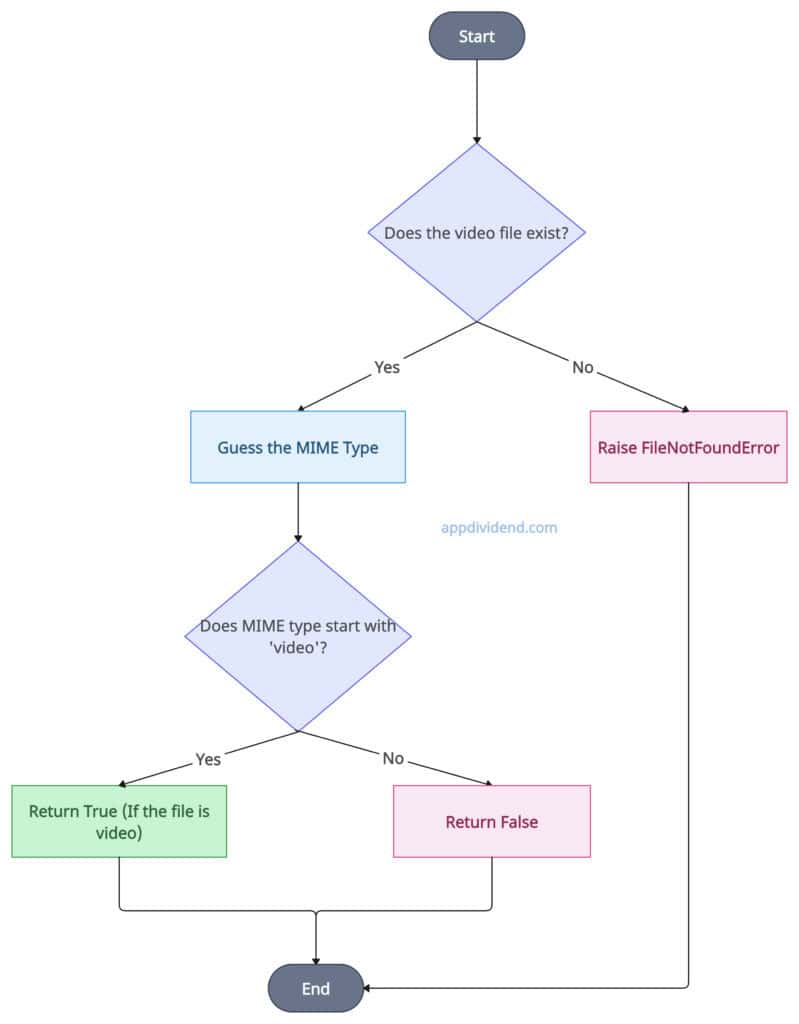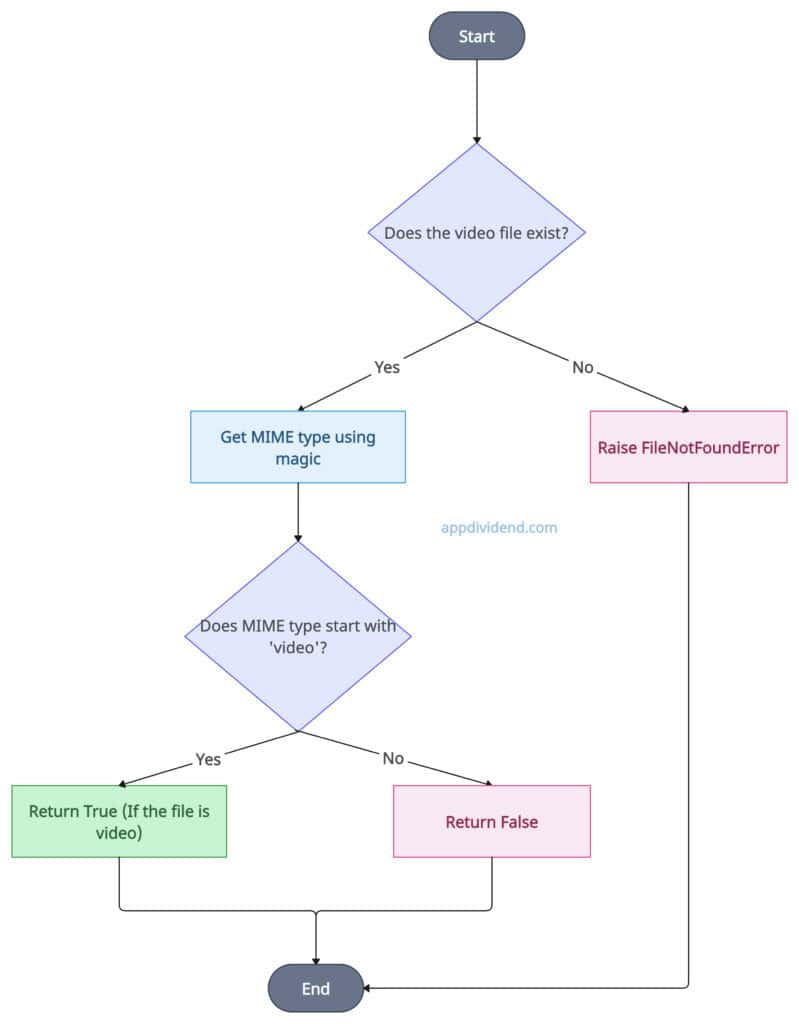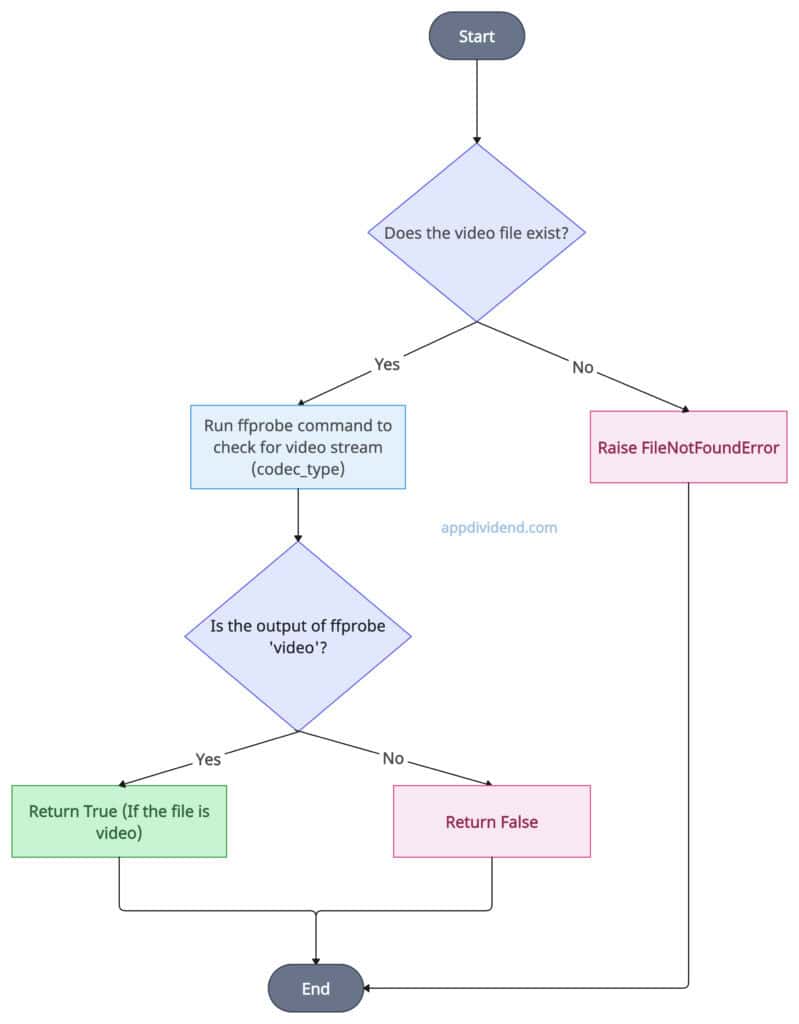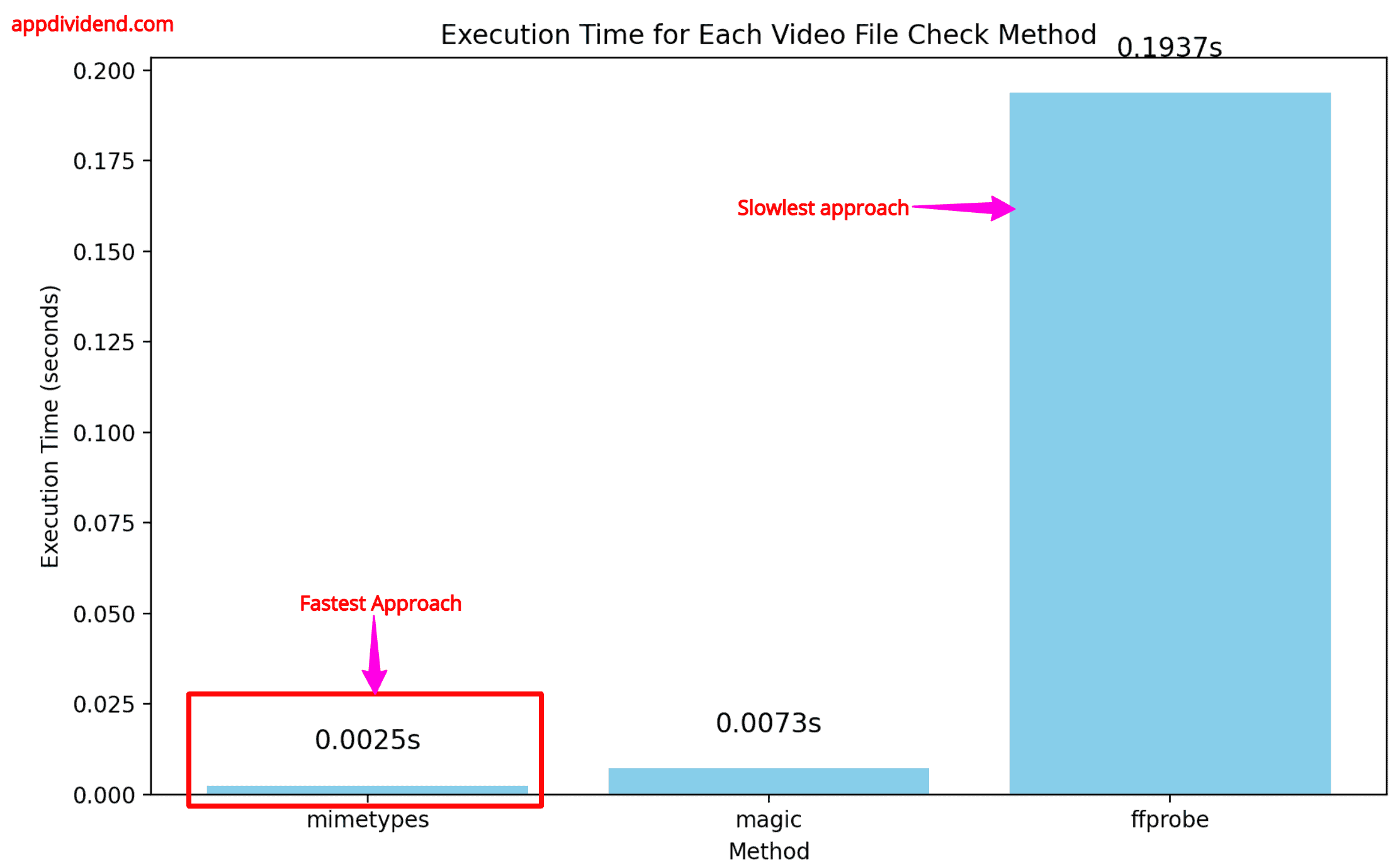Here are three ways to check if a file is a video in Python:
- Using mimetypes (built-in library)
- Using python-magic (third-party library)
- Using FFprobe command
Here is the “new.mp4” video file we will use to test our code:
Ensuring that the file I am working with is a video before processing prevents the error from occurring. It will help us improve the security of our application.
Method 1: Using mimetypes
The fastest and easiest way to check if an input file is a video is by checking its MIME type. The advantage of using this approach is that we don’t need to specify each video format.
The mimetypes module handles registered MIME types associated with file extensions.
You can tell from the above diagram that we first checked if the input file exists, and if it did, then retrieved the MIME type of the file. Check if the MIME type starts with ‘video’.
If it is a video, return True, indicating that the input file is a video.
import mimetypes
import os
def is_video_file(filename):
try:
# Check if the file exists
if not os.path.exists(filename):
raise FileNotFoundError(f"File '{filename}' not found.")
# Guess the MIME type based on the file extension
mimetype, _ = mimetypes.guess_type(filename)
# Return True if the file is a video, otherwise False
if mimetype and mimetype.startswith('video/'):
return True
else:
return False
except FileNotFoundError as e:
print(f"Error: {e}")
return False
except Exception as e:
print(f"An error occurred: {e}")
return False
# Usage
filename = 'new.mp4'
if is_video_file(filename):
print(f"{filename} is a video file.")
else:
print(f"{filename} is not a video file.")
Output
new.mp4 is a video file.
If I let’s say check for an image file, then it will give me the following output:
new.jpg is not a video file.
If the input file has an uncommon MIME type for a video, it may not be recognized. Furthermore, if it has the wrong extension, it may also provide the wrong answer.
However, determining the file type is a fast operation that requires less memory consumption.
The time complexity is O(1).
The space complexity is O(1).
Method 2: Using the python-magic library
Using the python-magic library, we can get the MIME type of the input file and check if it starts with “video/”, indicating that it is a video file; otherwise, it is not.
The python-magic library depends on the libmagic library, which you need to install first, based on your operating system. Since I am using MacOS, I will install it using the command below:
brew install libmagic
If you are using Windows or Linux, you should install it accordingly.
Now, you can install the “python-magic” library using the command below:
pip install python-magic
Code example
import os
import magic
def is_video_file(filename):
try:
# Check if file exists
if not os.path.exists(filename):
raise FileNotFoundError(f"File '{filename}' not found.")
# Get the MIME type of the file
mime = magic.from_file(filename, mime=True)
# Check if the MIME type starts with 'video/'
return mime and mime.startswith('video/')
except FileNotFoundError as e:
print(f"Error: {e}")
return False
except PermissionError as e:
print(f"Permission Error: {e}")
return False
except Exception as e:
print(f"An error occurred: {e}")
return False
# Usage
filename = 'new.mp4'
if is_video_file(filename):
print(f"{filename} is a video file.")
else:
print(f"{filename} is not a video file.")
Output
new.mp4 is a video file.
The python-magic library is highly accurate in determining whether a file is a video and recognizes a wide array of video formats.
However, as I mentioned earlier, it is a third-party library that relies on the libmagic software, which can complicate the setup process across different operating systems.
I highly recommend this approach if you are looking for accuracy. It is ideal for server-side file validation. If you are working with untrusted sources, it will help you determine various aspects of the file.
Method 3: Using the FFprobe command
If you are looking for a non-Pythonic way that is fast and highly accurate, then I recommend you use the FFProbe approach.
It requires the FFMpeg library, which you can download from this URL: https://www.ffmpeg.org/
From the above diagram, you can see that first, we checked if the file existed.
If the file exists, we run the ffprobe command to check for the video stream. If the output indicates a video, it means the file is a video file.
import subprocess
import os
def is_video_file(filename):
try:
# Check if the file exists
if not os.path.exists(filename):
raise FileNotFoundError(f"File '{filename}' not found.")
# Run ffprobe to check for video stream
result = subprocess.run(
['ffprobe', '-v', 'error', '-select_streams', 'v:0',
'-show_entries', 'stream=codec_type', '-of',
'default=noprint_wrappers=1:nokey=1', filename],
stdout=subprocess.PIPE,
stderr=subprocess.STDOUT
)
output = result.stdout.decode().strip()
# Check if the output is 'video'
return output == 'video'
except FileNotFoundError as e:
print(f"Error: {e}")
return False
except subprocess.CalledProcessError as e:
print(f"FFmpeg error: {e}")
return False
except Exception as e:
print(f"An unexpected error occurred: {e}")
return False
# Usage
filename = 'new.mov'
if is_video_file(filename):
print(f"{filename} is a video file according to FFmpeg using ffprobe")
else:
print(f"{filename} is not recognized as a video file by FFmpeg.")
Output
new.mov is a video file according to FFmpeg using ffprobe
The ffprobe method is slower due to spawning a subprocess. It requires ffmpeg to be installed on your machine.
The time complexity is O(n), where n depends on the file and FFMpeg’s processing time.
The space complexity is O(1).
Time measurement for execution
I measured the time for each of the above three approaches and concluded that “mimetypes” is the fastest method and ffprobe is the slowest. Here are my findings displayed as a bar chart.
Conclusion
The “mimetypes” is the best and fastest way if your video format is popular and registered globally. If you are looking for accuracy, the magic method can also be explored.
We did not explore the approach based on the file’s extension because it can sometimes lead to misleading and inaccurate results.

